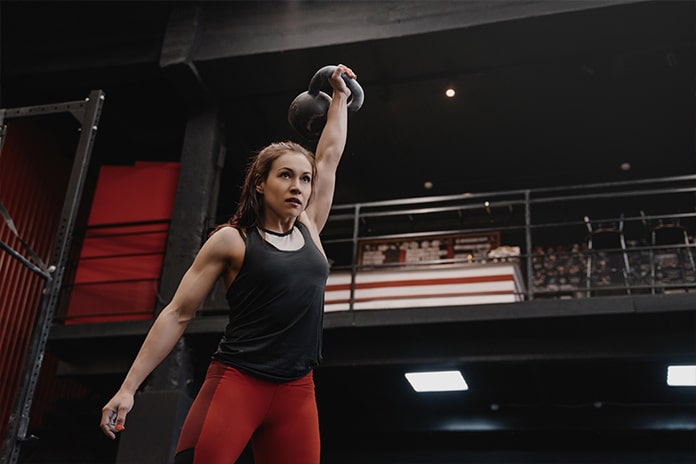Certain movements in CrossFit can make us cringe just hearing them or seeing them written on the whiteboard. Movements that equally test your strength, range of motion, and coordination. Typically a movement that taps into different wheelhouses simultaneously can be frustrating to achieve.
Here are 5 of the toughest movements in CrossFit:
Jump to:
1. Single-arm kettlebell overhead squat
That’s a mouthful. The overhead squat is a feat in and of itself—a movement that many struggle with. Flexibility, balance, strength, and coordination are all put to the test. Throw in the single-arm version, and you have an overhead squat on steroids. This unilateral exercise further taps into balance and overall coordination. Achieving full-depth is often difficult in this movement, as mobility can be a challenge. Tight hips contribute to the inability of getting deep into a good squat. Throwing a kettlebell overhead, with one arm, furthers the challenge. Tight shoulders are often the culprit in making this one of the hardest CrossFit movements. In general, a movement like this that requires an extreme range of motion is not programmed frequently in most boxes. Regardless, it’s probably not a movement that you should be training in excess without proper preparation. The risk of performing this exercise incorrectly is high if you already struggle with the overhead squat. Despite this, you shouldn’t avoid it altogether. Working up to complex unilateral movement like this one is valuable in tracking the growth and progress of your training.
2. The triple-under
Some of you might be shocked that’s even a thing. Well, it is! And it’s as difficult as it sounds. Ask any Games athlete and they’ll tell you 100 unbroken double-unders is a walk in the park. Triple-unders though, that’s another story. For many, it can take several months (sometimes years) to perfect the dreaded double-under. Throwing another rotation into the mix may seem overwhelming, but it is possible. The elevation of your jump has to see improvement before this exercise can be successfully implemented. Power in your jump and the overall height is crucial. Your body mechanics and coordination is again put to the test with this one. Smooth is always optimal when working on a skill like this one. Avoid whip marks by creating a steady, properly timed hop. The position of your body stays the same as it would with your dubs, but the overall speed, elevation, and timing of this movement increases. If you’ve mastered the art of the double-under, it may be time to take it to the next level and work on arguably one of the most challenging movements. Start by developing greater height in your double-under, preparing the body for this tough exercise.
3. The strict muscle-up
If you want a movement that requires an abundance of upper-body strength, coordination, solid core, and spot-on body mechanics, this is the one. Games athletes tend to make this one look effortless, deceiving large audiences as this is not the case when working on this ridiculously hard exercise. This gymnastics skill seriously tests the upper-body. Any weakness in this department will be highlighted in this one move. Contributing to its difficulty is the muscle-ups ability to utilize the “push” and “pull” movement all at once. Fluidity is also key in this exercise, forcing the body to synchronize the pull-up, sit-up, and dip required for a successful rep. Don’t let the movement fool you, though. If you think being able to perform a strong pull-up, sit-up, and dip means you’ll be able to master this gymnastics skill, then you will be sorely disappointed. The coordination required to tie all three movements together in a 1-2 second time-frame is much more difficult than it sounds. As if the challenges in this exercise weren’t enough, add in the need for solid grip strength and you can see why this move is labeled one of the toughest. Not only do you need a strong grip, but it’s also important to focus on proper grip positioning. The false grip, in this case, is essential.
4. The deficit handstand push-up
Adding one word to an already challenging movement can change everything. Standard handstand push-ups encapsulate a blend of upper-body strength, strict coordination, balance, and a bit of fearlessness. Not many people like being upside down like this. The deficit handstand push-up taps into all of these areas of your fitness while involving a deeper descent by utilizing plates or parallettes underneath your hands. When performing a traditional handstand push-up, the movement is cutoff when your head hits the floor right next to your palms. Deficit HSPUs allow you to take it a little further. The scapula sees more rotation during this downward movement, requiring a deeper range of motion, and more strength on the push up.
5. The L-sit
This savage exercise is done by supporting your entire body with the arms and simultaneously holding the legs out in front of you. Though your arms are supporting your body, your core is in overdrive here, doing most of the dirty work. If your core is an area of weakness, this movement will not be easy. As with all gymnastics movements, core is key. Success in this tough exercise is not seen in the number of reps accomplished, but rather in how long you can hold the L-sit. How often do you see an athlete holding an L-sit for longer than 30-seconds? Probably not a frequent sight. Shoulder mobility is another element required in this skill. A lack of this will throw off your positioning and prevent you from getting your legs off the ground. Tight hip flexors will also rear their ugly head in this movement and prevent you from holding the L-sit for a long period. Despite the challenges in this move, if you want to see a stronger core and ultimately a stronger CrossFit performance, this exercise should frequent your training sessions.
There you have it. 5 of the toughest movements in the CrossFit world. If you’re looking to challenge yourself and enjoy facing an inevitable bit of failure in your attempts, start finding ways to implement these complex moves into your regimen.















